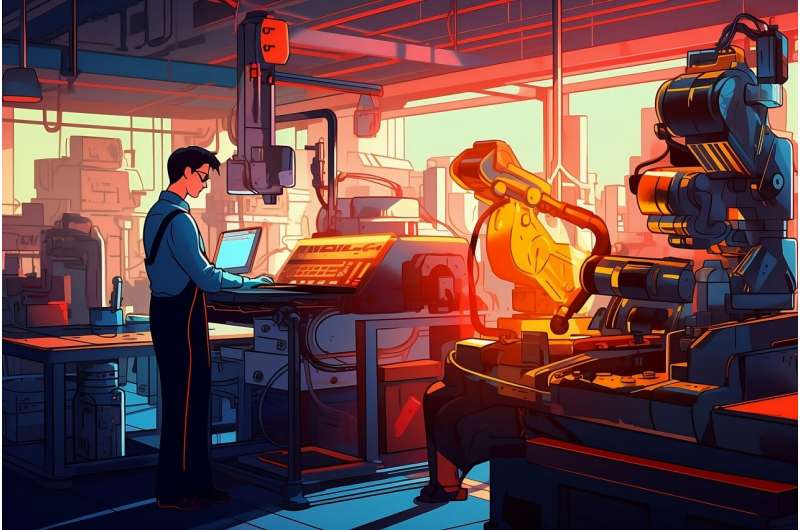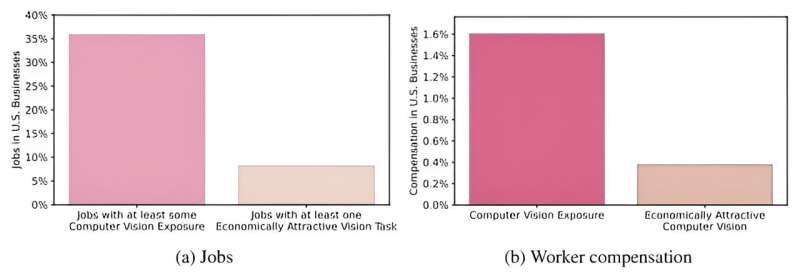This article has been reviewed according to Science X's editorial process and policies. Editors have highlighted the following attributes while ensuring the content's credibility:
fact-checked
trusted source
proofread
Rethinking AI's impact: Study reveals economic limits to job automation

Like many of us, you might find yourself nodding to a familiar digital doomsday chorus that vibrates through offices and coffee shops alike: AI will take my job!
Is this looming threat substantiated, or simply a manifestation of our shared anxiety in the wake of constant technological advancement? A new study from MIT CSAIL, MIT Sloan, The Productivity Institute, and IBM's Institute for Business Value is set to challenge our long-held beliefs.
Their research critically examines the economic practicality of using AI for automating tasks in the workplace, with a specific emphasis on computer vision.
Their findings show that currently, only about 23% of wages paid for tasks involving vision are economically viable for AI automation. In other words, it's only economically sensible to replace human labor with AI in about one-fourth of the jobs where vision is a key component of the work.
"This indicates a more gradual integration of AI into various sectors, contrasting with the often hypothesized rapid AI-driven job displacement," says Neil Thompson, Principal Investigator at MIT CSAIL and the Initiative on the Digital Economy. "We placed our focus on the field of computer vision, an area where cost modeling has seen significant advancements."
The study departs from the conventional broad-brush approach to AI's potential impact. Instead, it offers a meticulous examination of AI's feasibility in automating specific tasks. What sets this research apart is its tripartite analytical model. The framework assesses not just the technical performance requirements for AI systems, but also delves into the characteristics of an AI system capable of that performance, and the economic choice of whether to build and deploy such a system.
Many years of experience with computer vision provides abundant data to assess performance and economic viability. By contrast, the data for novel large language models is still developing. Fortunately, experience with computer vision models provides some insight into what the future might hold with the diffusion and adoption of language models. According to the researchers, development, deployment, and running costs might decline and the technology industry could transform to provide AI solutions as a service, eliminating the need for substantial capital investment.
The researchers looked at the ramifications of potential reductions in AI system costs and how such changes could influence the pace of automation. For example, if the costs of implementing AI in workplaces decrease significantly, this could accelerate the rate at which AI is adopted in various sectors, potentially leading to more rapid changes in the job market. Conversely, if computing requirements expand, if data becomes harder to find, and if skilled workers are scarce, higher costs could slow this transition, allowing more time for workers and industries to adapt.
Another critical aspect: AI-as-service platforms. The scientists showed how scalability and wider application could potentially change the landscape of task automation, shifting the focus from individual firm-level deployment to a more expansive, service-based approach. "The implications of this shift are profound: it could democratize access to AI technologies, allowing smaller businesses and organizations to benefit from AI without the need for extensive in-house resources. Moreover, this could lead to the emergence of new business models centered around AI services," says Thompson.
"When the semiconductor industry created an entirely new business model 20 years ago with the separation of design and manufacturing with production outsourcing, fabless semiconductor companies became the standard," says Martin Fleming, former IBM Chief Economist and Chief Analytics Officer and now a Fellow at The Productivity Institute, based in the U.K. "In the years ahead, its possible software, cloud services, and consulting firms will create a new business model with a class of companies specializing in AI-as-a-Service at scale."
The study's implications extend beyond immediate economic considerations, touching on broader societal impacts such as workforce retraining and policy development. It opens up avenues for further research into AI's scalability, cost-effectiveness, and its potential to create new job categories. As certain jobs are automated, for instance, there will be a growing need for roles focused on managing, maintaining, and improving AI systems, as well as roles in areas where human skills are irreplaceable by AI.
Further, to the extent that reduced AI costs, new AI services, or both succeed in contributing to improved productivity growth at the macroeconomic level, employment and income growth will quicken and living standards will improve. "Broad economic benefits will only be realized when fundamental transformation occurs in how business is done and how workers work," says Fleming.

New business models are beginning to emerge. For example, small jewelers benefit from a diamond classification tool built by NavTech in which a jeweler supplied image is graded to instantly establish quality without the availability of an experienced jeweler.
For autonomous vehicles, Nvidia has built a platform employing high-performance computing, imaging, and AI enabling continuous improvement and deployment through over-the-air updates. Individual vehicle manufacturers no longer have the need to build duplicate capabilities such as stereo camera and route recognition technologies.
"As AI continues to advance and reshape industries, we hope that the findings from this study will be a pivotal reference, guiding future explorations and policy-making in the ever-evolving intersection of technology, economics, and the labor market to help navigate the challenges and opportunities presented by the ongoing integration of AI into the workplace," says Thompson.
"Much has been written about the future impact of AI on the labor market, primarily using measures of exposure. However, these estimates often rely on the assumption that if a job can be automated, it will be," says Antonin Bergeaud, Associate Professor of Economics at HEC Paris.
"Svanberg and co-authors' research adopts a fresh perspective by meticulously estimating the costs of implementing these technologies, from installation to maintenance. It finds that even an AI system that is 'only' as good as a human would often be prohibitively expensive to adopt, compared to current labor costs in the U.S.
"The conclusion is striking: a much smaller share of the labor market is at risk of automation than direct estimations based on exposure would suggest. This important result commands a more systematic evaluation of the feasibility of adopting a new technology for an industry, which directly relates to the New Solow Paradox, where firms may fail to adopt an overperforming technology if the barriers are too high."
More information: Beyond AI Exposure: Which Tasks are Cost-Effective to Automate with Computer Vision? futuretech-site.s3.us-east-2.a … yond_AI_Exposure.pdf



















